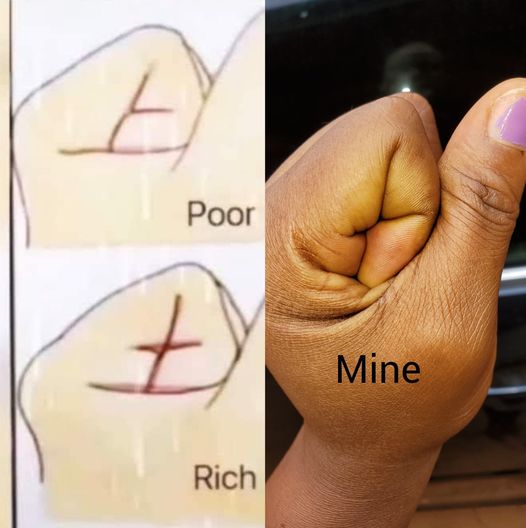Palmistry Fundamentals: Decoding Wealth and Destiny Through Palm Lines
Palmistry, also referred to as chiromancy, is an age-old art practiced to reveal insights into an individual’s personality, future, and even financial potential. By interpreting the lines, shapes, and unique features on a person’s palm, practitioners believe they can uncover details about character traits, life path, and even economic prospects. This practice has captivated many cultures across centuries, with individuals intrigued by the idea that one’s luck, wealth, or personal qualities could be foretold by the lines on their hands. According to traditional beliefs, specific line formations or locations on the palm might hint at one’s potential for wealth or financial struggles, adding a mystical allure to palmistry that continues to this day.
“Poor” vs. “Rich” Lines in Palmistry
One well-known example in palmistry demonstrates the contrast between financial outcomes based on the appearance of hand markings. In a popular visual, two different hand markings are shown side-by-side, each associated with a distinct financial prediction. The first part of the image displays a closed palm with a faint cross near the thumb, labeled as “Poor.” This depiction suggests that the presence of a light or broken cross near the thumb indicates financial challenges or limitations, as the lack of depth in the lines is said to reflect struggles in achieving material success.

In contrast, the lower part of the image showcases a different hand with a prominent cross near the thumb, labeled as “Rich.” Within the framework of palmistry, this deeper, well-defined cross is believed to signify financial prosperity. Advocates of palmistry maintain that such markings suggest a natural inclination toward resourcefulness and stability, which could contribute to financial success. Although these readings are often regarded as entertainment, for many, the lines on their palms offer a lighthearted view of their potential for financial comfort.
Global Interpretations of Palmistry
Palmistry is not confined to one culture; its interpretations and practices vary widely across different societies. In Indian Vedic traditions, for example, palmistry is closely intertwined with astrology. Practitioners analyze palm lines in conjunction with astrological elements to create a holistic forecast of an individual’s life, including financial prospects. Similarly, in Chinese culture, palmistry is used to predict one’s health, life path, and prosperity. Western culture adopted palmistry in the Middle Ages, continuing through the Renaissance, where it became a popular method for interpreting personality traits and predicting the course of one’s life.
Many folk traditions assign meaning to specific line patterns—such as crosses, forks, or deep, uninterrupted lines—that are believed to signal elements of one’s destiny, including financial outcomes. In various European customs, for instance, intersecting lines or unique markings near the thumb are associated with wealth or economic success. Folklore often describes the lines on one’s hand as symbols “writing” one’s fate, suggesting that certain markings reflect prosperity or adversity awaiting the individual. For some, these interpretations carry comfort or amusement, connecting them to ancestral wisdom about life and fortune.
Modern Skepticism and Scientific Views
Despite its long history, palmistry is generally met with skepticism in scientific circles. Most scientists and contemporary thinkers regard it as a form of pseudoscience—an interesting concept but lacking a solid factual foundation. Studies indicate that physical attributes of the hands, such as lines, shapes, and textures, are predominantly influenced by genetics rather than destiny. These features form during fetal development, leading science to dismiss any link between hand lines and one’s future, career success, or wealth.
Many psychologists explain the appeal of palmistry as an example of confirmation bias. This cognitive bias means that individuals may interpret their palm lines in ways that align with their current beliefs or situations. According to this theory, people tend to find significance in the lines on their palms because it reflects what they already perceive or hope about their lives. As a result, many view palmistry as more of an entertaining pastime than a credible means of forecasting financial destiny.
The Lasting Appeal of Palmistry as Fun and Tradition
Despite its lack of scientific validation, palmistry remains a captivating practice for those who appreciate the blend of cultural tradition and self-reflection. Whether one sees it as insightful or merely recreational, the idea that our hands could hold clues to our future—whether in wealth, love, or life journey—is undeniably intriguing. Palmistry provides an opportunity to contemplate life’s potential pathways, offering a whimsical exploration of what might lie ahead.
For some, interpreting palm lines can be a fun exercise in envisioning personal goals or aspirations. Others may approach it as a spiritual or cultural practice, taking comfort in the belief that their palms hold hints about their destiny. Regardless of one’s stance, palmistry continues to spark curiosity about what our hands might reveal about our financial or personal futures. Though science may not back it up, the notion that wealth or adversity could be “written” into our hands remains a compelling reminder of humanity’s fascination with life’s mysteries.
In an age where individuals seek meaning in both traditional and modern ways, palmistry offers an accessible form of self-reflection, even if just for fun. This centuries-old practice, passed down through different cultures and interpretations, keeps alive the enchanting idea that something as simple as a palm line could provide glimpses into the unknown. Whether one takes palmistry as mere amusement or sees it as a way to explore deeper truths, its charm lies in connecting people with a timeless curiosity about life and fate.


